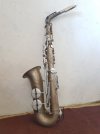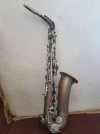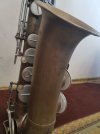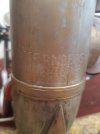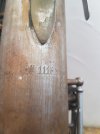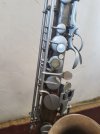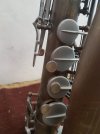You are using an out of date browser. It may not display this or other websites correctly.
You should upgrade or use an alternative browser.
You should upgrade or use an alternative browser.
please help me identify this alto saxophone
- Thread starter Vezirov Timur
- Start date
"étonnante" means "astonishing" or "surprising" in English. I do see that there are a couple variant spellings, too. Hey, I took Latin in high school and college, not French.
That being said, I think it's probably not a French make, and it's at least 1940s, but probably much later. Is there a "made in" stamp on the horn?
Edit: crossed out my wrongness.
Edit: crossed out my wrongness.
Last edited:
Thank you Pete. I contacted the same Sternberg musical instrument factory in Budapest (I can give you an email) where these saxophones were brought for sale. Gyorgy Mihaly, one of the museum staff refers to the fact that (I quote verbatim) "Etonante is a French brand that sells its products in Sternberg. Of course between 1920 and 1940, later of course not!" Of course this confuses me! Since in France at that time, in my opinion, Selmer were produced. As for the stencils, there were a small number of them! But! You can also take into account the fact that most likely it was produced in some kind of handicraft workshop
Unfortunately, it doesn't say where it was made. I honestly saved him from imminent death !!! They wanted to stick it to the wall in the pub. It's a pity!!! It has also been painted. A layer of chromium (or nickel) was torn off with sandpaper. Idiots!!!! I can't say anything more! I made pillows myself, though without resonators. Sounds very cool! Build straight!!! Another interesting thing! How did he get to us? Especially to Central Asia??? The main thing is that I did not let him die!
translated this word. u t see what goes like the word amazing"étonnante" means "astonishing" or "surprising" in English. I do see that there are a couple variant spellings, too. Hey, I took Latin in high school and college, not French.
That being said, I think it's probably not a French make, and it's at least 1940s, but probably much later. Is there a "made in" stamp on the horn?
Attachments
* There were hundreds of little shops in France that made saxophones. Selmer is probably the best known French saxophone manufacturer, but "best known" doesn't mean that you have a possibility that your horn was made by Selmer. I can guarantee your horn wasn't made by Selmer.
* "Amazing" and "astonishing" are synonyms. "Surprising" is close enough. As I said, I took Latin in school, not French. In any case, it's just a label.
I don't know why I didn't check Google or I did and I didn't post here. I will blame my muscle relaxers for back pain. Anyhow ...
Your horn is a Rene Guenot stencil. (Rare NSFW warning: some of the Guenot ads have topless women.)
Your horn has reduced key work: it's missing the chromatic F# key and doesn't look like it has an articulated G# mechanism. This description sounds like the "Model 0," after you bought some add-ons, or the "Simplimax" version of the horn.
I think that the serial number is based on the model of the horn, not a brand total. In other words, serial number 123 refers to the 123rd Model 1929, not the 123rd horn that Rene Guenot produced. That essentially means that I have no idea how old the horn is. Early as 1934 and as late as at least 1938, just based on catalogs. I don't know when Rene Guenot stopped producing horns. Start of WWII? Through WWII?
1. I read that these horns are high pitch. "High pitch" is a tuning standard. Modern or low pitch is A=440hz (some orchestras use A=442hz). High pitch is A=467hz. That means that your horn can't play in tune with other instruments and your horn can't be made to play in tune. (Note that some people do solder on an extension to the neck and fiddle with the tone holes. This can help, but you'll still have difficulties.) To check, you need someone to play next to you or an electronic tuner.
2. This is not a professional model horn and wasn't a professional model when it was released.
3. If the horn is high pitch, it's value is close to $0. If it's low pitch, maybe $100 to $200.
Oooh. That took 2 hours to write.
* "Amazing" and "astonishing" are synonyms. "Surprising" is close enough. As I said, I took Latin in school, not French. In any case, it's just a label.
I don't know why I didn't check Google or I did and I didn't post here. I will blame my muscle relaxers for back pain. Anyhow ...
Your horn is a Rene Guenot stencil. (Rare NSFW warning: some of the Guenot ads have topless women.)
Your horn has reduced key work: it's missing the chromatic F# key and doesn't look like it has an articulated G# mechanism. This description sounds like the "Model 0," after you bought some add-ons, or the "Simplimax" version of the horn.
I think that the serial number is based on the model of the horn, not a brand total. In other words, serial number 123 refers to the 123rd Model 1929, not the 123rd horn that Rene Guenot produced. That essentially means that I have no idea how old the horn is. Early as 1934 and as late as at least 1938, just based on catalogs. I don't know when Rene Guenot stopped producing horns. Start of WWII? Through WWII?
1. I read that these horns are high pitch. "High pitch" is a tuning standard. Modern or low pitch is A=440hz (some orchestras use A=442hz). High pitch is A=467hz. That means that your horn can't play in tune with other instruments and your horn can't be made to play in tune. (Note that some people do solder on an extension to the neck and fiddle with the tone holes. This can help, but you'll still have difficulties.) To check, you need someone to play next to you or an electronic tuner.
2. This is not a professional model horn and wasn't a professional model when it was released.
3. If the horn is high pitch, it's value is close to $0. If it's low pitch, maybe $100 to $200.
Oooh. That took 2 hours to write.
Well, at least something is already known where he comes from. And stenciled again! I would rather not play it in all keys. But in unison, you can
Thank you Pete!!!!
Thank you Pete!!!!
By the way, here is the link where I do the first test on it. Haven't even taken the paint off yet.

